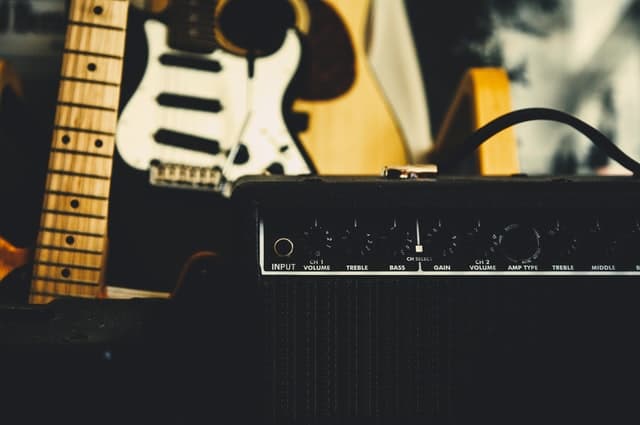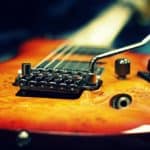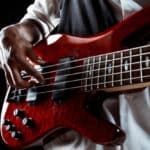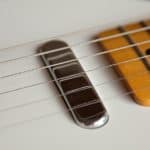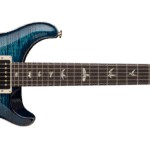We musicians use a lot of expressions that probably don’t make sense to anyone outside our circle.
Hey, even sometimes we don’t know what others are trying to say with their fancy words.
If you are here, this might have happened to you, and perhaps you might still be wondering what “scooping the mids” actually means.
Scooping the mids of an amp means just turning down the frequencies that take over the mid-range of the spectrum, and this can be done with the “mid” EQ knob of almost any amp. A scooped mid or “V” EQ works great on rhythm guitar for staying out of the range where vocals and other instruments shine.
In this article, I will go in-depth about every detail relative to scooping the mids of a guitar amp.
From how to do it, to when to do it to why doing it in the first place.
After leaving this page you will have a clearer idea about why this kind of EQ is so important for certain genres, and if you should worry about using it or not.
Are you ready to get started?
Let’s go!
What is a “scooped” tone?
A scooped tone generally refers to a sound where the mid-range of frequencies is less present.
Although it might be hard to listen for a beginner, especially in the context of a full band, a scooped guitar tone usually sounds a bit hollow and open.
This can be achieved in a few different ways and is very common in genres such as Rock, Hard Rock, and Metal.
It has fans and detractors, but knowing it’s a thing won’t harm you, and at worse will be another tool on your belt for when you need it.
Examples of a scooped mids guitar tone
The thing with guitar tones is that no matter how creative one can be with words to describe them, there’s nothing like hearing them for yourself.
Here are a few great examples of scooped sounds:
And now a funny counterfactual:
How do you “scoop” the mids of your amp?
Scooping the mids of your amp is pretty simple, you just turn down the “middle” EQ knob.
If your amp doesn’t have a mids EQ knob, a good workaround would be using an EQ pedal.
How much should you turn it down will depend on what you hear it’s happening and how that works within the sonic landscape of your band or project.
Some players just go all the way, and some others prefer just a dip to make room for other important parts such as vocals or other lead instruments.
There’s no secret formula for achieving a scooped sound, and it will work based on your active experimentations.
Why would you want to scoop the mids of your amp?
Scooping the mids of your amp will mainly work to make room for other instruments in your full band mix.
Have you ever heard of “cutting through the mix”?
That’s another funny expression musicians tend to use.
It’s quite simple though: Having the full spectrum of frequencies a human could hear in mind. Songs are usually tweaked so the different instruments occupy the range where they shine with more presence.
For instance, you would expect the bass drum and the bass guitar to take up the lower end, while cymbals are the kings of the high end.
The midrange is a rather contested space where you could have guitars, keyboards, synths, and voices fighting for the spotlight.
Bumping down a bit of mids on any of these instruments will make some room for the others to breathe.
Finally, in some genres of metal guitar, the scooped mids EQ is very popular and part of what makes its particular sound.
Is “V” EQing the same as scooping mids?
A “V” EQ is the same as scooping mids.
It just refers to the shape a graphic EQ would have with a very drastic dip in mids.
Of course, this is just a way of materializing the concept and you probably wouldn’t want to go with such a steep and broad drop in mids.
Usually “V” EQs keep some low and high mids.
Should you always scoop the mids on your amp?
As a guitar player, it’s important to know that you shouldn’t always scoop the mids on your amp or overall signal chain.
This is unless you are exclusively a rhythm player and you have just found out that this kind of sound is what works best for you.
In any other case, and in many situations you will really want to fill that midrange and take that space in the frequency spectrum for you.
For soloing, playing melodies, or certain riffs, having strong mids could be very important.
However, I won’t say for certain it is, because there are no real rules for music and I’m sure somebody could come up with a great example of a player doing the absolute opposite and still sounding great.
What I want to say to you, however, is that, again, there are no magic recipes, and you should find your own sound, and it could change from song to song, or from section to section.
Try new things out, experiment, listen and try other new things then.
Can you also scoop lows or highs?
With guitar and many other instruments scooping mids is not the only common EQ, it’s also common to cut the low and or high range.
Doing so is usually referred to as applying a high-pass or low-pass filter, respectively.
Bringing back the idea of different instruments taking for themselves certain parts of the broad spectrum in a song, you could easily imagine the need of just cutting the frequencies where a guitar, for instance, has nothing to do.
Why would you need the lowest low end of a guitar if you already have a bass playing there?
And why would you want the harsher highest frequencies of this instrument if that place could better suit the cymbals or other instruments?
Perhaps you can come up with a great answer to these questions, and that’s why, again, there are no strict rules for doing anything in music, however, these are things many producers and engineers have to ask themselves when working on songs.

Hello there, my name is Ramiro and I’ve been playing guitar for almost 20 years. I’m obsessed with everything gear-related and I thought it might be worth sharing it. From guitars, pedals, amps, and synths to studio gear and production tips, I hope you find what I post here useful, and I’ll try my best to keep it entertaining also.

